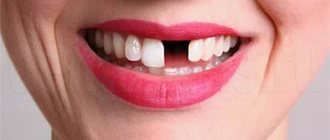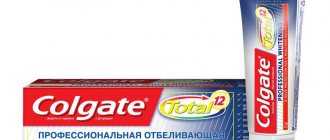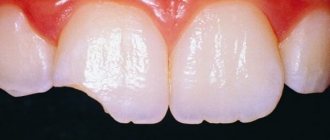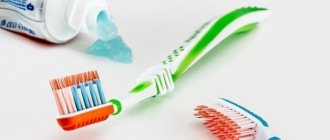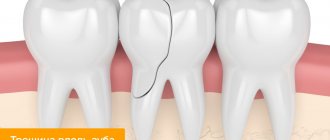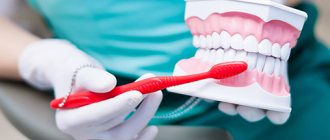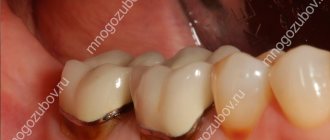Reasons for chipping
A chipped tooth should certainly alert a person. If this happens, then something is certainly going wrong in life and health. To understand better, you need to know the most common causes.
- A dental injury has occurred.
- Weak immune system.
- Incorrect and careless wearing of structures installed by an orthodontist.
- Hormonal imbalance.
- Eating junk food.
- The presence of dental diseases in an untreated state.
- Malocclusion.
- Unhealthy arrangement of adjacent teeth.
- Presence of caries.
- Having bad habits.
- Low acidity in the mouth.
- Damaged filling.
- Tooth enamel is subject to reminilization.
- The presence of a long-formed crack.
- Presence of chronic diseases.
Let's look at some of the reasons separately. An incorrect bite undoubtedly leads to chipping and damage to soft tissue. The lower and upper teeth injure each other even during normal eating. Also, people with this type of bite experience night grinding, which wears away the enamel over time. If a piece of a tooth breaks off near the soft tissue, complex caries will soon appear in this place.
Chips, bruises, displacement or loss of teeth can occur as a result of injury. For example, due to a fight, a fall or a strong blow. But in our lives, milder dental injuries occur. For example, a slight injury can be caused by hard candies (caramel) or the simultaneous intake of cold and hot foods (coffee and ice cream).
Bad habits also damage our teeth. Alcohol and tobacco use greatly weaken tooth enamel. As a result, cracks soon appear on it, which inevitably turn into chips.
Dental health depends on nutrition. The acid-base balance in the mouth is greatly disrupted by improper carbohydrate nutrition. This reason also thins the enamel. Only healthy food provides the necessary microelements to strengthen it.
The scourge of our century is diabetes. It occurs in every third resident. Elevated sugar levels lead to hormonal imbalance, which in turn affects the teeth. Thyroid disease can also be included in this category.
Hot and cold food causes cracks to appear. Severe caries damages the enamel and increases its fragility.
Symptoms
The symptoms of a chipped tooth are as follows:
- The functions of the dentofacial apparatus are impaired.
- Cracks are visible on the enamel.
- Filling falling out.
- The tooth is open, the nerve endings are exposed.
- The dental crown is broken.
In addition, the person suffers from pain and severe sensitivity. The sensation of strong or weak pain depends on the nature of the chip. A broken piece usually results in a reaction to temperature changes.
What complications can there be?
The gradual destruction of the figure eight inevitably leads to the development of inflammatory processes, because a crown with large chips quickly becomes a breeding ground for harmful bacteria. In this case, the damage rapidly spreads deep into the hard tissues, moving to dentin and pulp. This situation is fraught with the appearance of acute symptoms: severe pain and the onset of suppuration processes. Urgent removal of the causative element is required, but such conditions significantly complicate the doctor’s task. If the cause is caries, the pathology can easily spread to the adjacent molar and lead to its destruction.
Types of chips
There are several types of chips:
- Dentin chipping.
- Enamel chip.
- Enamel crack.
- Chipping and opening of the pulp.
The hard enamel material definitely requires attention and care. Often a person does not worry about her health. Eating carbohydrate foods, hard foods, poor care and unhealthy habits destroy enamel and lead to cracks and chips. Chips of enamel do not cause discomfort, so people do not rush to the hospital with them. In vain. In the absence of enamel, the load on the tooth increases significantly. Pathogenic bacteria enter the open area, which begins to destroy the entire tooth. As a result, the entire dentition may be affected. A person is greatly distressed by a chipped front tooth, which does not look aesthetically pleasing.
Dentin is the hard mineralized part of the tooth. It is located near the nerve and pulp chamber. This part of the tooth corresponds to the shape. In terms of hardness, dentin is slightly weaker than enamel, but stronger than that of bones. The most dangerous situation for dentin is moderate chipping. Because of them, dentin is washed out and damage to the pulp chamber occurs. If you do not build up a tooth, you may soon lose it completely.
A pulp fracture causes severe pain. Painkillers provide only a temporary effect. With such symptoms, the pulp is removed and the canals are cleaned. In addition, the doctor performs tooth restoration and prosthetics.
What to do if a tooth chips
The first action of the patient is to contact the dentist. There's no need to panic. The situation is not fatal. Initially, you need to independently assess the severity of the damage and rethink your actions. For mild to moderate cases, you should make an appointment in the coming days. The main thing is not to delay. If the pulp is exposed, you must rush to the dentist on duty. Otherwise, the pain will be severe and the patient will not be able to eat or sleep.
Help at home
It is necessary to organize and provide yourself with pre-medical care:
- First step: rinse your mouth with water.
- Second action: apply an ice compress and reduce gum swelling. In case of bleeding, apply a medical bandage.
- Third step: take painkillers analgesics. Here you can also put a bandage with novocaine on the aching place.
It is better not to throw away a small broken piece, but to show it to the doctor. The broken bone tissue may be needed to restore the enamel.
The first two actions will help reduce discomfort, the third action will remove pain. Further treatment will be carried out by the doctor.
Treatment by a doctor
The dentist uses several methods to treat a broken tooth:
- Artistic restoration.
- Veneers and lumineers.
- Dental inlays.
- Dental crowns.
The first method is used if there is minor mechanical damage to the face. Composite materials are used for restoration purposes. At the same time, the shades of the materials are different. They are necessary for more accurate color selection. Using a special material, the tooth is given the correct shape.
If there are gaps in the teeth in addition to cracks and chips, the dentist decides to install veneers or lumineers. These orthodontic devices are made from ceramic material. The devices are attached to the front teeth and apparently hide the chip.
For more serious damage, a dental inlay is installed. This device allows you to restore a significant part of the tooth. It is made specifically for each patient in a laboratory.
If half a tooth or more is missing, it is replaced with prosthetics. That is, a dental crown is installed on top of the damaged tooth, which makes the tooth aesthetically pleasing and protects it from further destruction.
Diagnostics
The most reasonable decision a person can make when a crack appears on a crown or a part of it breaks off is to consult a dentist.
During the examination, the doctor will determine the extent of the existing destruction and say whether the unit can be restored or whether it will have to be removed.
The final decision is always made based on the results of x-ray diagnostics, which shows:
- whether the root zone is injured;
- in which direction the crack goes and how far it extends;
- whether the surrounding tissues are displaced.
Special cases
Some teeth are restored in their own ways. Let's look at them.
Wisdom tooth
If a chip appears on this tooth, it is not restored. The procedure makes no sense. The fact is that this chewing organ is not involved in the chewing process and is not important for the species. Dentists remove a chipped wisdom tooth.
Front tooth
The situation with chipped front teeth seems deplorable to public citizens. In this case, the dentist may offer different treatment methods. For example, artistic restoration. The dentist will use a paste to select the desired color and restore the tooth. The material is resistant, durable and imitates naturalness well. The doctor will fix the applied layer with special light radiation. It is impossible to determine from the appearance that the patient’s tooth has been restored using extensions.
The second way to restore a tooth is to use a veneer. It is used for serious injuries. The material is strong, resistant, durable and does not change color over time.
In the third case, they resort to installing a crown. For these purposes, zirconium oxide, ceramics or metal ceramics are used. The choice of material is influenced by the patient’s opinion and ability to pay.
Lateral teeth
The same restoration methods can be used on the side teeth as on the front teeth. However, this is not entirely justified. These teeth are hidden from the eyes of others. Therefore, to restore them, you can use a regular filling. But it is better to resort to the extension method. Veneers are not installed on lateral teeth.
If a nerve has opened up on a side tooth, the dentist will first do an antiseptic treatment, perhaps remove the diseased nerve or the entire tooth and make a new one again.
Baby tooth
A parent often makes the mistake of thinking that it is not worth taking a child to the hospital with baby teeth. It's in vain. If your baby teeth are chipped or cracked, your doctor will stop further decay using a filling or preservative gel. For chipped incisors, a special gel is mainly used. Healthy baby teeth will lead to healthy permanent teeth.
Children are especially often injured. This happens due to falls or blows. The resulting chips lead to further stomatitis and increase tooth sensitivity. Therefore, a visit to your pediatrician is important.
It is important for the child to carry out the following pre-medical measures:
- Calm a frightened child.
- Give your child water to rinse his teeth.
- If soft tissues are damaged, disinfect them.
- Be sure to save the broken tooth for the doctor.
Within the first 24 hours, a child with a chipped tooth should be shown to a doctor. During the appointment, the doctor will most likely take pictures of the baby, which will help check the condition of the roots and soft tissues. For chipped incisors, a special gel is mainly used.
Special case - vertical crack
The vertical crack does not appear to be dangerous. It's a lie. It seriously hurts the pulp. As a result, it is not possible to restore the enamel with a filling. In serious cases, the patient feels that one half of the tooth is loose. In serious cases, the patient feels that one half of the tooth is loose.
In the case of a small crack, pressure is applied to the teeth. As a result, the tissue gradually loses its integrity. The result of this state of affairs is a big chip. If you go to the dentist, they will cover up a small crack, thereby restoring the enamel and health. If this action does not help, the doctor may install veneers or a crown.
First aid for pain relief
From time immemorial, gum inflammation has been treated by rinsing with decoctions of medicinal herbs, and often this folk method helps even more than painkillers. Most often, decoctions are prepared from chamomile, calendula, sage and oak bark. If you don’t have herbs on hand, you can use salt and baking soda. Here are some recipes.
- Pour two glasses of boiling water over two tablespoons of sage, chamomile or calendula (you can use a herbal mixture). Cover with a lid and leave for about an hour, then strain and cool to room temperature. Rinse the problematic tooth until the pain decreases.
- Over low heat, bring half a liter of water with six tablespoons of oak bark to a boil. Let it brew until it cools, then strain and rinse your mouth with warm broth. For effective results, rinsing is recommended every hour.
- Mix one teaspoon of regular table salt and the same amount of baking soda in a glass of warm boiled water and rinse the sore tooth. The more often you do this, the more significant the result will be. The best option: a glass of decoction every hour.
Remember that these recommendations will not eliminate the problem completely, but will only relieve the pain at first. Only a doctor can cope with painful teething.
Prevention
To prevent chipping of a part of the tooth you need to:
- Treat caries regularly.
- Avoid mechanical damage.
- Eat right and in moderation.
- Do not delay correcting your bite.
- Monitor the health.
A chipped tooth is a fixable matter. It is better to heal than to have complications later.
Sources used:
- Klyomin V. A., Borisenko A. V., Ishchenko P. V. Combined dental fillings. MIA, 2008
- Practical therapeutic dentistry" (Nikolaev A.)
- Scheller-Sheridan C (8 May 2013). Basic Guide to Dental Materials. John Wiley & Sons.
- Faculty of Dentistry and Medical Technologies St. Petersburg State University
How to reduce the likelihood of a fracture
In order for your teeth to be strong and cope with the chewing load, it is important to follow the rules of oral hygiene and undergo a preventive examination with a dentist once a year. Particular attention should be paid to nutrition - it should be complete and balanced. It is recommended to exclude from the diet foods that are too hard and difficult to bite into.
It is also important to treat caries in a timely manner to avoid damage to healthy tissue by the carious process. If necessary, you can take calcium supplements in courses - they will improve the quality of tooth enamel.
